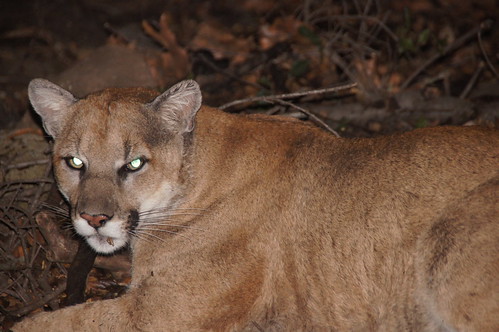Santa Monica Urbanization Poses Threat to Mountain Lion Survival

The mountains constitute an island of habitat surrounded on all sides, with Highway 101 to the north, the 405 Freeway to the east, the Pacific Ocean to the south and the Oxnard Agricultural Plain to the west.
"Because of how isolated the habitat is from other pieces of habitat, we don’t think that the Santa Monica Mountains can support more than 10 [lions], or maybe 15 at the absolute maximum," Kate Kuykendall, a National Park Service spokesperson, said.
A grown adult male mountain lion requires a home range of approximately 150 to 200 square miles, roughly the same as the entire East-to-West expanse of the mountains, Kuykendall estimated.
Due to their solitary behavior, mountain lions, also known as cougars or pumas, seek new territories once they disperse from their mothers around the age of one year. The only time they share an area with others is during mating season.
However, the current situation has led to the lions becoming more limited in their mobility, resulting in several obstacles to their health and survival.
"The National Park Service in the Santa Monica Mountains has been studying mountain lions for just over a decade and during the course of that study, the main cause of death for mountain lions is other mountain lions. And that’s maybe because they're compounded by the fact that they are kind of trapped on an island of habitat," Kuykendall said.
Even more troubling are the implications on genetic diversity. During mating season, pumas in the mountains often only find other lions who are closely related to them.
"There have already been two cases of first-order inbreeding, which is when the father mates with the daughter. That’s obviously a concern for the long term," Kuykendall explained.
Meanwhile, other mountain lions have attempted unsuccessfully to cross the manmade boundaries that impose on their natural need to migrate to new living spaces where they can be safe, find mates and a good food supply.
"The animals want to come into the Santa Monica Mountains from the north and the Santa Susana Mountains and above ... but there is this huge freeway there. So one lion was killed there during the government shutdown," Kuykendall said.
For this reason, the National Park Service has announced its desire to ensure safe passage by building a wildlife tunnel by Liberty Canyon, one of the few connecting spaces with natural habitat on both sides of the 101 Freeway. It was in this area that the lion tried to cross and was killed.
In addition, the pursuit of a new habitat has led some of the cougars to try to cross over on the south side as well, driving one particular cougar all the way to downtown Santa Monica, who was ultimately killed.

Another puma called P22 has recently drawn significant media attention for its successful escape to Griffith Park.
P22's advance into Griffith Park holds significant informational value, although the National Park Service doesn't know how he got there. He triggered a remote camera nearly two years ago and was ultimately captured by Jeff Sikich, a wildlife biologist, who then equipped him with a GPS collar.
The information gathered since has revealed the elusive nature of P22, who is estimated to be two or three years old. As his name suggests, P22 is the 22nd puma that the National Park Service has outfitted with a GPS collar so far to study their behavior.
"He is pretty seriously avoiding human contact," Kuykendall said. "If he wanted to be aggressive, he’d have ample opportunity to do so, but he is laying very low during the day and really only active at night and in the early morning and sticking to the most natural areas of the park with the least amount of humans."
At the same time, P22's time in the park is limited since he needs to leave in order to mate.
"He can't stay here forever and we are already surprised by how long he has been here ... That’s kind of part of what makes this so interesting," Kuykendall noted.
"Now that he has the GPS collar, when he will leave, we will have some better understanding of which wildlife corridor he takes," she continued. "Though it’s pretty amazing that he made it there, but it’s also a bit nerve-wrecking that he is gonna try to get out there at some point. "
Reach Contributor Alexander Wowra here.



